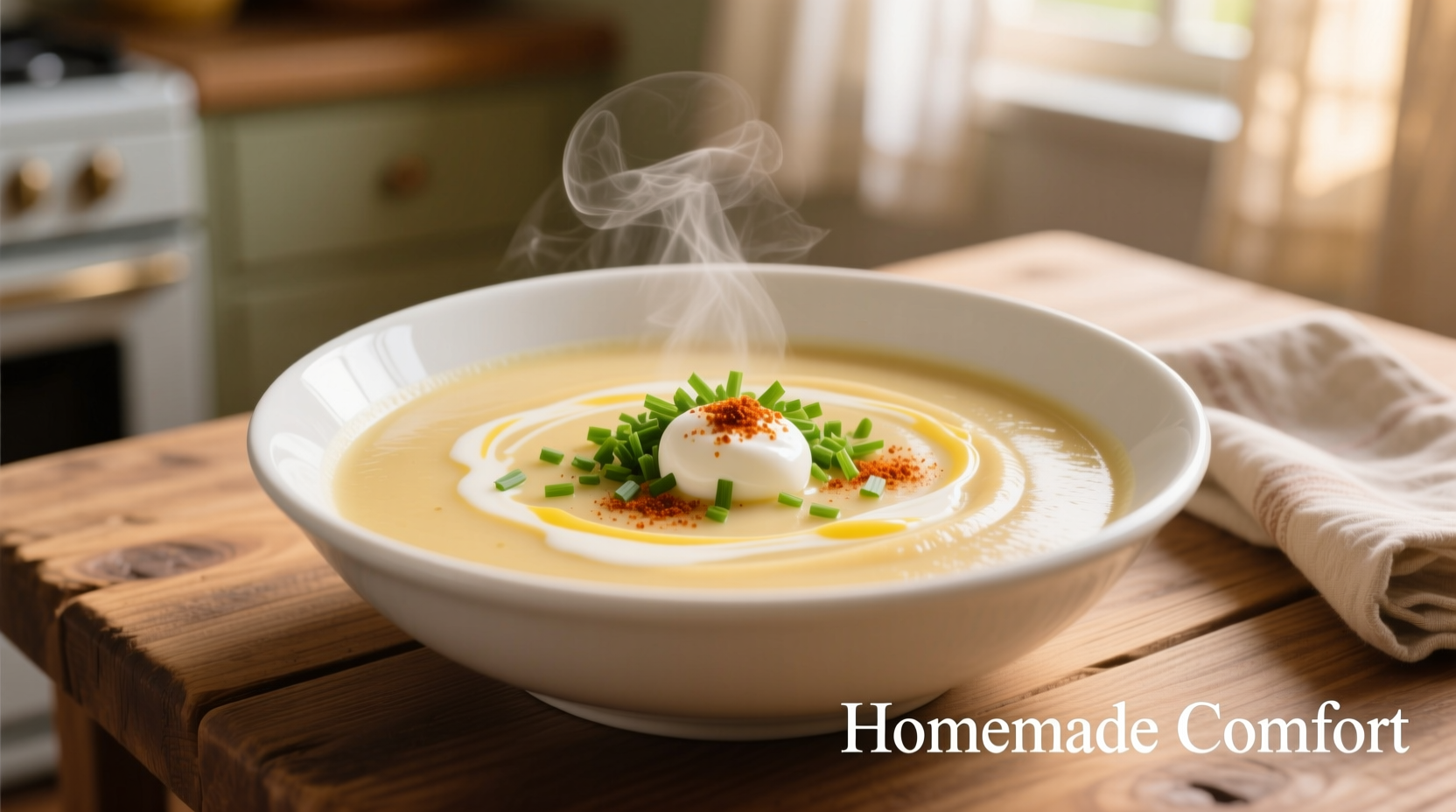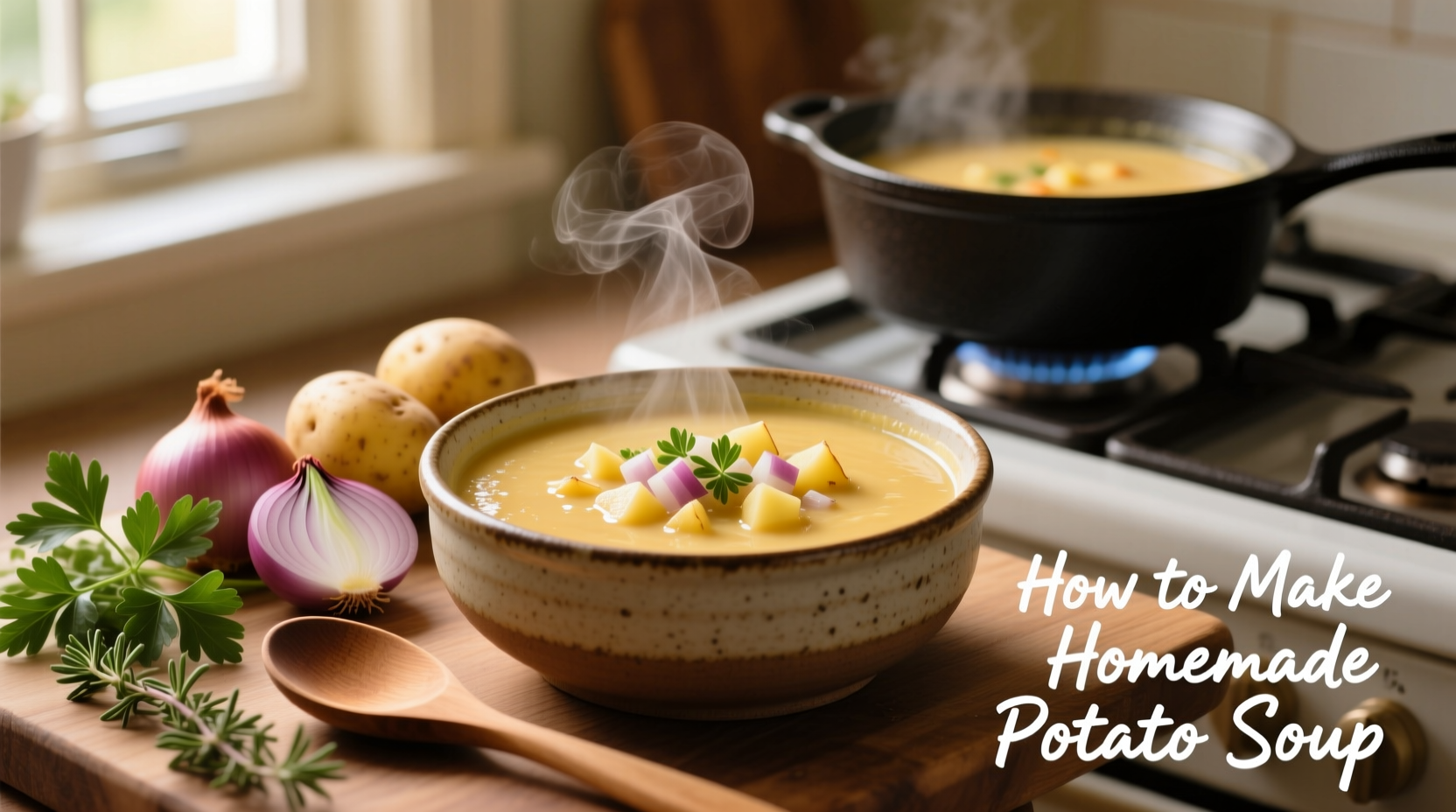Learning how to make homemade potato soup starts with selecting the right potatoes and understanding the science behind thickening. The best results come from starchy varieties like Russets combined with proper roux technique, not heavy cream overload. Follow these steps for restaurant-quality soup that's naturally creamy, deeply flavorful, and ready in under 45 minutes.
The Essential Potato Soup Framework
Professional kitchens follow a consistent structure for perfect potato soup every time. Understanding this framework helps you adapt based on available ingredients while maintaining quality.
| Component | Critical Function | Common Mistakes |
|---|---|---|
| Base Potatoes | Provides natural starch for thickening | Using waxy potatoes that don't break down |
| Aromatic Foundation | Builds flavor complexity | Rushing the sauté process |
| Liquid Ratio | Controls final texture | Adding too much liquid initially |
| Finishing Technique | Creates signature creaminess | Over-relying on dairy instead of potato starch |
Step-by-Step Cooking Process
1. Prepare Your Ingredients (10 Minutes)
Gather these simple ingredients for authentic homemade potato soup:
- 2 lbs Russet potatoes (peeled and diced into 1/2-inch cubes)
- 1 large yellow onion (finely chopped)
- 3 celery stalks (minced)
- 2 carrots (small dice)
- 4 cloves garlic (minced)
- 4 cups low-sodium chicken or vegetable broth
- 1 cup whole milk or half-and-half
- 4 tbsp unsalted butter
- 1/4 cup all-purpose flour
- Salt and freshly ground black pepper to taste
- 4 strips bacon (optional, for garnish)
2. Build Flavor Foundations (12 Minutes)
Heat a large Dutch oven over medium heat. Cook bacon until crisp if using, then remove leaving 2 tablespoons of fat. Add onions, celery, and carrots. Sauté until translucent (about 8 minutes), stirring occasionally. Add garlic and cook for 1 minute until fragrant. This slow cooking process develops the Maillard reaction that creates complex flavor compounds professional chefs rely on.
3. Create the Roux (5 Minutes)
Add butter to the pot and melt completely. Sprinkle in flour while stirring constantly to create a smooth paste. Cook for 2-3 minutes until golden but not browned. This blond roux technique prevents floury taste while providing essential thickening power without needing excessive cream.

4. Simmer to Perfection (15 Minutes)
Gradually whisk in broth, ensuring no lumps form. Add potatoes and bring to a gentle boil. Reduce heat and simmer uncovered for 15 minutes, or until potatoes are fork-tender but not disintegrating. Proper cooking temperature (180-200°F) is critical—boiling too vigorously breaks down potatoes too much, creating a gluey texture.
Food Safety Temperature Guidelines
According to USDA Food Safety and Inspection Service, potato soup should reach 165°F minimum for safe consumption. Use an instant-read thermometer to verify internal temperature before serving, especially when reheating leftovers. Maintain holding temperatures above 140°F to prevent bacterial growth during serving.
Source: USDA Food Safety Basics
5. Finish and Serve (3 Minutes)
Remove 2 cups of soup and blend until smooth using an immersion blender or regular blender (cool slightly first). Return to pot along with milk. Stir gently over low heat for 3 minutes—do not boil. Season with salt and pepper. The partial blending technique creates natural creaminess through potato starch rather than relying solely on dairy.
Achieving Perfect Texture Every Time
Professional chefs emphasize these texture control techniques:
- Uniform dicing: Cut potatoes to identical 1/2-inch cubes for even cooking
- Temperature control: Simmer gently at 180-200°F (not boiling)
- Partial blending: Blend only 25-30% of the soup for optimal thickness
- Dairy addition: Add milk off-heat to prevent curdling
Potato Soup Evolution Timeline
Potato soup has evolved significantly since its origins:
- 1570s: Potatoes introduced to Europe from South America
- 1700s: First documented potato soup recipes appear in French culinary texts
- 1830s: Irish immigrants popularize potato-based soups in North America during famine
- 1950s: Canned versions become supermarket staples
- 2000s: Artisanal, from-scratch versions regain popularity
Customization Options for Every Preference
Adapt this basic recipe to suit dietary needs and flavor preferences:
Dietary Modifications
- Vegan version: Substitute butter with olive oil, use vegetable broth, and replace milk with unsweetened cashew cream
- Gluten-free: Replace flour with 2 tablespoons cornstarch mixed with cold broth
- Lower calorie: Use skim milk and reduce butter to 2 tablespoons
Flavor Variations
- Loaded baked potato: Add 1/2 cup shredded cheddar, 1/4 cup sour cream, and chives
- Broccoli cheddar: Stir in 2 cups chopped broccoli during last 5 minutes of cooking
- Smoky bacon: Double the bacon and add 1/2 teaspoon smoked paprika
- Herb garden: Stir in 2 tablespoons fresh thyme and 1 tablespoon chopped rosemary
Storage and Reheating Best Practices
Proper storage maintains quality and safety:
- Refrigeration: Store in airtight container for up to 4 days
- Freezing: Freeze without dairy for up to 3 months; add milk when reheating
- Reheating: Warm gently over medium-low heat, stirring frequently
- Texture adjustment: Add small amounts of broth if too thick when reheated
Nutritional Comparison
Homemade potato soup offers significant nutritional advantages over commercial versions:
| Nutrient | Homemade (per cup) | Canned (per cup) |
|---|---|---|
| Calories | 220 | 280 |
| Sodium | 380mg | 890mg |
| Fat | 10g | 12g |
| Fiber | 3g | 2g |
Source: USDA FoodData Central
Troubleshooting Common Issues
Solve these frequent potato soup problems:
- Too thin: Simmer uncovered to reduce, or make a slurry of 1 tbsp cornstarch + 2 tbsp cold water
- Too thick: Gradually add warm broth until desired consistency
- Grainy texture: Potatoes overcooked—next time reduce simmer time by 3-5 minutes
- Bland flavor: Underseasoned—add salt in layers throughout cooking process
- Curdled dairy: Milk added to boiling soup—always temper by adding small amounts of hot soup to milk first











 浙公网安备
33010002000092号
浙公网安备
33010002000092号 浙B2-20120091-4
浙B2-20120091-4